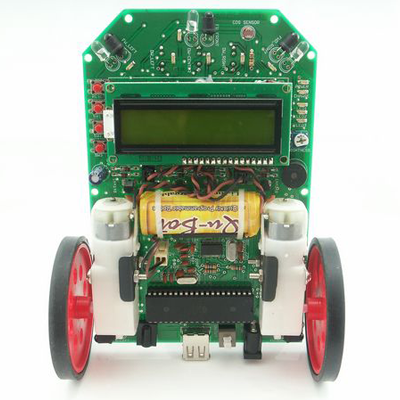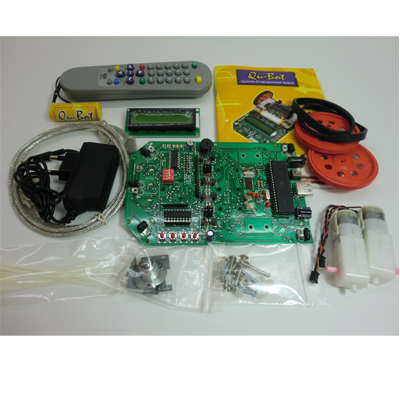Qu-Bot is a Quickly Programmable Robot. Qu-Bot is specially designed for beginners in robotics and for all kind of robotics enthusiasts, starting from small kids to adults. The Qu-Bot visual interface software allows the robot to be programmed easily and quickly.
The Qu-Bot Robot Kit is a very easy to assemble, programmable robotic kit that comes complete with a variety of sensors, motors, controller board, remote control, visual icon based software QBVLab, battery, charger, manual. Virtually everything you need to build, code, program and execute the program. This product is geared towards classroom and group instruction of fundamentals of robotics. Bulk discounts and classroom multi-packs are available. Please contactenquiry@robot-hk.comfor inquiries.
The Qu-Bot Robot kit connects to the PC via USB cable (included) and is programmable through an easy-to-use QBVLab drag and dropmodular icon based software program. After the program sequences have been uploaded into the robot via USB, it can be controlled by remote control or can behave according to the user defined parameters.


The Qu-Bot runs on Li-ion battery and offers hours of endless educational entertainment. Also the battery can be recharged by USB or charger included in the kit. This is an entry level product that requires no programming or robotics experience. A great practical tool for hands-on in the field of robotics.
Qu-Bot can simply turned for following operations.
- Line Follower Robot
- Wall Hugger Robot
- Object Tracer Robot
- Light Tracer Robot
- Hand Hugger Robot
- Obstacle Avoider Robot
- Intelligent Grid Mover Robot
- Remote Controlled Robot
- PC USB Controlled Robot
- Maze Solver Robot
- Sumo Robot
Qu-Bot Salient features:
- Easy and simple to use
- No soldering or gluing required
- Made for complete beginners (No knowledge of Robotics or Programming needed)
- Develop skills of microelectronics, programming, robotics and sensors
- Assembles in 10minutes - easy and quick start into robotics, no soldering or gluing required
- Virtually all items included. Nothing needs to be bought seperately. Eg. Tools, battery, charger, remote, USB Cable etc.
- USB connectivity for maximum compatibility with all Windows PC's and Laptops
- Easy Icon-based visual programming for beginners - sample programs included
- Onboard li-ion rechargeable battery which can run Qu-Bot for more than 3 hours.
- Battery charged through USB or special charger
Input Modules Onboard:
- 3X Proximity Sensors
- 3X Line Follower Sensors
- 2X Motor Counter Sensors
- 1X Remote Control Receiver Sensor
- 1X Ambient Light Sensor
- 3X General Purpose Switches
Output Modules Onboard:
- 1X 16X2 Character LCD
- 3X General Purpose LED's
- 2X Motors & Motor Drivers
- 1X Buzzer
- 1X USB TX & RX
Other Board Features:
- 1X Power Indication LED
- 1X Charge Indication LED
- 1X 4 Way Sensor Selection Switch
- 8X Sensor State Indication LED's
- 1X Reset Switch
- 1X Power On/Off Switch
- 1X DC Input Jack
Qu-Bot Package Includes:
- 1X Fully Assembled Main Circuit board with all above features
- 1X Li-ion Rechargeable Battery 3.7V, 1.4Ah with protection circuit
- 2X Geared DC motors
- 2X Mounting Clamps for motor
- 2X Wheels
- 1X Castor
- 1X USB Cable
- 1X Remote Control
- 1X Battery Charger Adaptor
- 1X CD with all software and documentation
- 1X Printed Manual
- All screws, nuts and cable ties
Tools Required assembling Qu-Bot:
- Screw driver
- Pliers or spanner
Qu-Bot Visual Lab
Qu-Bot Visual Lab V4.0 (Updated 29th December 2010) is now available for download.Click here to download.
The Qu-Bot Visual Lab is a Visual Programming software for Qu-Bot. QBVLab offers an interface with which anyone can program Qu-Bot very quickly, easily and without having any prior knowledge of programming. QBVLab enables the Qu-Bot to be used by anyone from kids to adults.
The latest version of software also includes programmer software for loading .hex or .bin files compiled for ATMega16. These files can be compiled in any AVR compiler which supports ATMega16. Now Qu-Bot can be programmed in Visual, C, Basic or any other programming language and used without modifying hardware or removing chip.
Below are some sample codes made in QBVLab which shows how easily robot can be programmed and used. For more information download user's manual and QBVLab software fromDownloadssection.
1. Bugler alarm

Burgler Alarm using Qu-Bot
This sample code shows the basic application of sensors and buzzer.
- When any of the front sensors senses an object the buzzer goes on for infinite time.
2. Obstacle avoider

Obstacle Avoider using Qu-Bot
This sample code shows how Qu-Bot can be programmed to make an obstacle avoider robot.
- LCD is initialized to show status of robot.
- The robot starts moving when switch 1 is pressed because there is a while conditional loop on top.
- By default robot keeps moving forward at speed 7
- When front sensor senses obstacle the robot moves backwards for 500 ms and takes a left turn for 200 ms at speed 10
- When left or right sensor senses an obstacle the robot stops opposite side motor to take turn in reverse direction.
3. Edge avoider

Edge Avoider using Qu-Bot
If the robot is kept on a table surface with this code programmed, the robot moves forward by default whenever it senses edge (Bottom sensors doesn't sense table surface) it takes actions accordingly.
- By default the robot moves forward.
- If the bottom center sensor doesn't detect table surface (moves out of edge) robot moves backward and takes a turn
- If bottom left or right sensor moves out of edge the robot takes turn in opposite direction.
- Be careful when using robot with this code programmed. Sometimes there is a chance of robot falling down. Keep alertness to grab the robot if it falls down.
4. Distance measurement

Distance Measurer Qu-Bot
This sample code shows how to move robot for specific distance using encoder sensors mounted near wheels. This code is made to move robot forward for approximately 1 meter.
- The diameter of the Qu-Bot wheel measures 66.3 mm. So the periphery of the wheel becomes 208.182 mm (nD = 66.3 x 3.14 ).
- The wheel has 8 holes in it so it gives 16 counts (8 on + 8 off) when it rotates 1 revolution. In one revolution it moves forward to 208.182 mm distance (periphery of wheel). So at each count we get distance of 208.182 / 16 = 13 mm. This is also the accuracy which we get when the robot moves on motor count.
- If we want robot to move forward to 1 meter robot has to go forward until it gets 77(1000/13) motor counts on motor counter.
- So this is how it works. When switch1 is pressed robot starts moving forward. The right motor counter is already initialized at code start.
- The while condition checks until the motor count reaches 76. We need 77 counts but there is some inertia when the motors are stopped, so the robot moves a little forward when motors stop, and we get approximately 1 meter move.
5. Line Follower using one sensor

Single Sensor Line Follower
This code uses only one sensor to follow a dark color line on light colored floor.
- In the start robot starts running left motor. Right motor is stopped. So the robot takes a long right turn.
- When it gets the line under the bottom sensor it continues to take right turn until it crosses it completely.
- After a small delay of 50ms the left motor stops and right motor starts moving so robot takes a left turn.
- Again it continues taking the left turn until it crosses the line. After a 50 ms delay the procedure repeats because of infinite loop.
6. Line Follower using three sensors

Line Follower using Three Sensors
This code uses 3 bottom sensors to make Qu-Bot follow a dark color line on light color surface.
- When the bottom center sensor is on the dark line the value is 0. This means the robot is on the line. It will move forward in this condition.
- If the bottom center sensor goes off, either left or right sensor will encounter the line. If left sensor senses the line, left motor stops and right motor runs at full speed so robot takes a left turn and comes back on line.
- If Right sensor encounters line right motor stops and left goes on full speed so robot takes right turn and comes back on line.
7. Remote Controlled Qu-Bot

Remote Controlled Qu-Bot
Programming this code into Qu-Bot makes it a manual remote controlled robot.
- When any switch is pressed on IR remote, it transmits a RC5 code. In the remote included with this kit the code is from 1 to 127.
- There are 4 big arrow keys on the center of remote. This code uses them for moving robot.
- Any key of the remote can be used to create any action on robot. The 4 arrow keys have IR codes of 32(Up), 33(Down), 17(Left) & 16(Right).
- The key codes of other keys can be recognized by printing the IR Input variable to LCD or serial Terminal on PC.
- For manual control robot there is a simple loop. For any input of IR out of 4 keys the robot gives specific action.
8. PC controlled Qu-Bot

PC Controlled Qu-Bot
Qu-Bot has a facility to communicate with PC through USB. Connecting the USB cable creates a Virtual Serial Port on PC. Through this port serial communication can be done with PC. This communication is called UART (Universal Asynchronous Receiver Transmitter). There are different terminal software's available for serial communication like HyperTerminal and bray's terminal.The QBVLab software itself includes a terminal. In advanced applications it's possible to control Qu-Bot from the inputs of mouse, keyboard, webcam, internet or any other source available on PC.However this needs a high level of programming and hardware knowledge on PC but this sample code gives a demo on how to move Qu-Bot on commands taken from keyboard.
- In an infinite loop the robot seeks for UART input. When a key from A, S, D and W is pressed terminal sends the characters to robot and it takes appropriate action by moving itself to left, back, right or forward.
Downloads
No recommended products at the moment.
No recommended products at the moment.